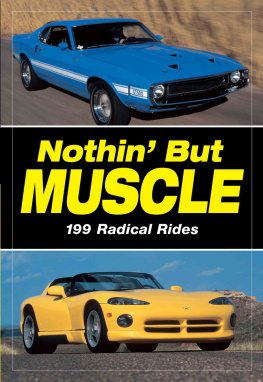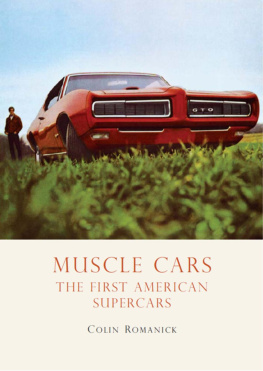MUSCLE CARS

Mike Mueller

First published in 2010 by Motorbooks, an imprint of MBI Publishing Company, 400 First Avenue North, Suite 300, Minneapolis, MN 55401 USA
Copyright 2010 by MBI Publishing Company
All rights reserved. With the exception of quoting brief passages for the purposes of review, no part of this publication may be reproduced without prior written permission from the Publisher.
The information in this book is true and complete to the best of our knowledge. All recommendations are made without any guarantee on the part of the author or Publisher, who also disclaims any liability incurred in connection with the use of this data or specific details.
We recognize, further, that some words, model names, and designations mentioned herein are the property of the trademark holder. We use them for identification purposes only. This is not an official publication.
Motorbooks titles are also available at discounts in bulk quantity for industrial or sales-promotional use. For details write to Special Sales Manager at MBI Publishing Company, 400 First Avenue North, Suite 300, Minneapolis, MN 55401 USA.
To find out more about our books, visit us online at www.motorbooks.com.
ISBN-13: 978-0-7603-3837-7
Digital edition: 978-1-61060-112-2
Hardcover edition: 978-0-7603-3837-7
Editor: Peter Schletty
Designed by: Chris Fayers
Front cover image: Robert Kerian/Transtock Images
Printed in China
CONTENTS
INTRODUCTION
Theyre all museum pieces now: Olds 4-4-2s and Super Sport Chevelles, Z/28 Camaros and Boss Mustangs, 413 Mopars and 427 Fords, AMXs and Hemi Cudas. While these vehicles varied widely in size and shape, they all had one thing in commonthey ran like hell. Forty-something years ago we knew these high-powered haulers as supercars. The popular moniker then morphed into muscle car not long before this bullish breed began fading from Main Street U.S.A. in the early 1970s.
By most definitions, the original muscle car era officially began in 1964 and ended roughly 10 years later. It was Pontiac that reportedly ushered in this energized age by introducing a groundbreaking machine that, as Car and Drivers David E. Davis Jr. later wrote in 1975, appeared on the American scene like a Methodist minister leaving a massage parlor. No, the legendary GTO wasnt the first American car to offer obscene amounts of horsepower. It was the way Pontiac packaged its new and improved brand of performance that had the congregation swooning.
Before the GTO came along, big cubes in big cars wearing big price tags represented the only way to fly for American buyers with a need for speed. Hot cars in the early 1960s included Chevys famed 409, Chryslers luxurious 300 letter-series cars, and 406 Galaxies from Fordall full-sized flyers weighing in at more than 2 tons. Pontiac planners, on the contrary, felt that less could be more. Their idea was so simple: Take a relatively lightweight midsized body shell, stuff it full of big-car engine, throw in a bit of heavy-duty hardware and a stick on the floor, then top it all off with a price more easily reached by the younger speed-hungry set, or those young at heart.
Public response was so hot the competition couldnt help but jump up onto this runaway bandwagon. GTO rivals first appeared within the corporation, with Oldsmobile transforming its midsized F-85 into the 4-4-2 midway through 1964. Buicks Gran Sporta more upscale variation on the muscle car themeappeared in 1965, followed closely by Chevrolets SS 396 Chevelle, the popular street racer that eventually superseded the GTO as Americas best-selling muscle car in 1969.
Retaliation from Ford Motor Company included Mercurys Cyclone, a midyear addition for 1964. Chrysler Corporation got its act rolling in 1966 with its awesome 426 street Hemi, a 425-horse monster that made for the perfect power option for Dodges new, sleek Charger. The following year, Plymouth introduced its 440-powered GTX, which also could have be fitted with an optional Hemi.
Nineteen sixty-seven was also the year that General Motors joined Ford in the pony car field, and both Chevrolets new Camaro and Pontiacs Firebird featured high-powered alter-egos. The track-ready Z/28 Camaro appeared late in 1967 with a high-winding, 302-cube small-block to go along with the SS 396 version already on the market. Pontiac and Ford followed suit in 1969 with their own road-racing ponies, the Trans Am Firebird and Boss 302 Mustang, respectively. Meanwhile, once-stodgy American Motors was toying with its two-seat AMX and more traditional Javelin.
By 1969, muscle cars were available in all sizes, from full-sized boulevard brutes like Chevrolets SS 427 Impala to petite pony cars like Pontiacs Firebird 400. Plymouths Road Runner, introduced in 1968, was intended to be a budget supercar; its bare-bones, no-nonsense nature allowed buyers to put their money where it mattered mostunder the hood. This no-frills approach was then overshadowed by Dodges 1969 Charger Daytona and Plymouths 1970 Superbird, two winged wonders that could hit 200 miles per hour on National Association for Stock Car Racing (NASCAR) tracks and looked as if they could on the street as well. Equally outrageous was the advertised output rating that appeared in 1970 for the Chevrolets top-dog SS 454 Chevelle. The LS6 454-cubic-inch Mk. IV big-block was rated at 450 horses, and for once the advertisers werent blowing smoke. Talk about obscene amounts of horsepower.

Every one of these factory hot rods owed its existence to the GTO. But what was the key to this powerful Pontiacs initial success in 1964? The message was straight-line speed, continued David E. Davis in his 1975 Car and Driver retro tribute. And it felt like losing your virginity, going into combat, and tasting your first beer all in about seven seconds. As for the historic aspect, the 1964 GTO was, in Davis always far-from-humble opinion, the first Muscle Car... a violent, virile catalyst-car that set the pace and tone for five or six years of intense horsepower promotion out of Detroit city, the hallmark of a period that seemed like the culmination of all the dreams of all the enthusiasts on all the back roads in this country, but a period that in reality was nothing more than thatthe period at the end of one short paragraph of automotive history.
Short indeed. A victim of itself, as well as changing attitudes, the American muscle car quickly skyrocketed in popularity, reaching its zenith in 1970, and then even more rapidly raced to its demise. Nineteen seventy-one was the last year for legends like Chryslers Hemi and Fords 429 Cobra Jet, and only GM was actively marketing muscle machines after 1972. Arguably the last great American muscle car, Pontiacs 455 Super Duty Trans Am came in 1973 and went in 1974. It would take the better part of 10 years before horsepower again started regaining marketability.
Detroits original muscle car era was essentially over by 1975. Performance models have since been reborn and are running as strong as ever at present, but for how much longer? Guess its once again a matter of enjoying the ride as long as it lasts.
CHAPTER 1 MUSCULAR MILESTONES












